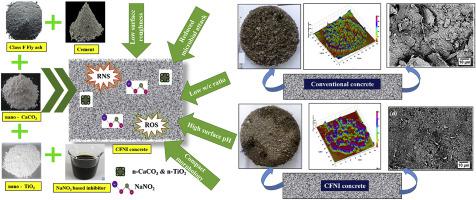当前位置:
X-MOL 学术
›
Int. Biodeterior. Biodegrad.
›
论文详情
Our official English website, www.x-mol.net, welcomes your feedback! (Note: you will need to create a separate account there.)
Enhanced biodeterioration and biofouling resistance of nanoparticles and inhibitor admixed fly ash based concrete in marine environments
International Biodeterioration & Biodegradation ( IF 4.8 ) Pub Date : 2020-11-01 , DOI: 10.1016/j.ibiod.2020.105088 Manu Harilal , B. Anandkumar , B.B. Lahiri , R.P. George , John Philip , Shaju K. Albert
International Biodeterioration & Biodegradation ( IF 4.8 ) Pub Date : 2020-11-01 , DOI: 10.1016/j.ibiod.2020.105088 Manu Harilal , B. Anandkumar , B.B. Lahiri , R.P. George , John Philip , Shaju K. Albert

|
Abstract In this paper, we report the enhanced biodeterioration and biofouling resistance of a modified fly ash based concrete, formulated by the addition of fly ash, nano-TiO2, nano-CaCO3, and corrosion inhibitor into conventional concrete. After six months of exposure in natural seawater, the modified fly ash based concrete showed a three to four order reduction in aerobic and anaerobic bacterial density, which was confirmed by epifluorescence and confocal microscopic investigations. The FESEM micrographs showed a characteristic surface morphology with uniform distribution of more calcium silicate hydrate (CSH) gels and aluminate hydrates, absence of discontinuities, pits, and cracks on the modified concrete surface which helped to resist the ingress of aggressive ions from seawater. The comparatively lesser reduction in surface pH, low water/cement ratio, better bulk thermal properties, and low surface roughness facilitated the improvement in the antimicrobial and antifouling properties of modified concrete. The addition of nanoparticles and inhibitor increased the hydration of cement resulting in the formation of more portlandite which got converted into more hydration products, producing a pore free morphology. The inherent photocatalytic activity of nano-anatase TiO2 and bactericidal activity of sodium nitrite due to the presence of reactive nitrogen species (RNS) together enhanced the biofouling and biodeterioration resistance.
中文翻译:

纳米颗粒和抑制剂掺加粉煤灰混凝土在海洋环境中的增强生物降解性和抗生物污染性
摘要 在本文中,我们报告了通过在常规混凝土中添加粉煤灰、纳米 TiO2、纳米 CaCO3 和缓蚀剂配制而成的改性粉煤灰混凝土的增强的生物劣化和抗生物污染性。在天然海水中暴露六个月后,改性粉煤灰基混凝土的好氧和厌氧细菌密度降低了三到四个数量级,这通过落射荧光和共聚焦显微镜研究得到证实。FESEM 显微照片显示出特征性的表面形态,更多的硅酸钙水合物 (CSH) 凝胶和铝酸盐水合物均匀分布,改性混凝土表面没有不连续性、凹坑和裂缝,这有助于抵抗来自海水的侵蚀性离子的进入。表面 pH 值的降低相对较小,低水灰比、更好的整体热性能和低表面粗糙度有助于改善改性混凝土的抗菌和防污性能。纳米颗粒和抑制剂的加入增加了水泥的水化,导致形成更多的硅酸盐,这些硅酸盐转化为更多的水化产物,产生无孔形态。由于活性氮物质(RNS)的存在,纳米锐钛矿TiO2的固有光催化活性和亚硝酸钠的杀菌活性共同增强了生物污垢和生物降解性。纳米颗粒和抑制剂的加入增加了水泥的水化,导致形成更多的硅酸盐,这些硅酸盐转化为更多的水化产物,产生无孔形态。由于活性氮物质(RNS)的存在,纳米锐钛矿TiO2的固有光催化活性和亚硝酸钠的杀菌活性共同增强了生物污垢和生物降解性。纳米颗粒和抑制剂的加入增加了水泥的水化,导致形成更多的硅酸盐,这些硅酸盐转化为更多的水化产物,产生无孔形态。由于活性氮物质(RNS)的存在,纳米锐钛矿TiO2的固有光催化活性和亚硝酸钠的杀菌活性共同增强了生物污垢和生物降解性。
更新日期:2020-11-01
中文翻译:

纳米颗粒和抑制剂掺加粉煤灰混凝土在海洋环境中的增强生物降解性和抗生物污染性
摘要 在本文中,我们报告了通过在常规混凝土中添加粉煤灰、纳米 TiO2、纳米 CaCO3 和缓蚀剂配制而成的改性粉煤灰混凝土的增强的生物劣化和抗生物污染性。在天然海水中暴露六个月后,改性粉煤灰基混凝土的好氧和厌氧细菌密度降低了三到四个数量级,这通过落射荧光和共聚焦显微镜研究得到证实。FESEM 显微照片显示出特征性的表面形态,更多的硅酸钙水合物 (CSH) 凝胶和铝酸盐水合物均匀分布,改性混凝土表面没有不连续性、凹坑和裂缝,这有助于抵抗来自海水的侵蚀性离子的进入。表面 pH 值的降低相对较小,低水灰比、更好的整体热性能和低表面粗糙度有助于改善改性混凝土的抗菌和防污性能。纳米颗粒和抑制剂的加入增加了水泥的水化,导致形成更多的硅酸盐,这些硅酸盐转化为更多的水化产物,产生无孔形态。由于活性氮物质(RNS)的存在,纳米锐钛矿TiO2的固有光催化活性和亚硝酸钠的杀菌活性共同增强了生物污垢和生物降解性。纳米颗粒和抑制剂的加入增加了水泥的水化,导致形成更多的硅酸盐,这些硅酸盐转化为更多的水化产物,产生无孔形态。由于活性氮物质(RNS)的存在,纳米锐钛矿TiO2的固有光催化活性和亚硝酸钠的杀菌活性共同增强了生物污垢和生物降解性。纳米颗粒和抑制剂的加入增加了水泥的水化,导致形成更多的硅酸盐,这些硅酸盐转化为更多的水化产物,产生无孔形态。由于活性氮物质(RNS)的存在,纳米锐钛矿TiO2的固有光催化活性和亚硝酸钠的杀菌活性共同增强了生物污垢和生物降解性。



























 京公网安备 11010802027423号
京公网安备 11010802027423号